Apr 13, 2025
Apr 13, 2025
Located at 10 ºN of the Equator and tucked between the Pacific Ocean and Caribbean Sea, Costa Rica with its incredible tropical rain forests and cloud forests is an unbelievable paradise that is bound to melt the heart of any nature lover. We arrived in the capital city of San Jose and after a night’s rest, headed to the mountains in the quaint hamlet of San Ramon. We stayed at Villa Blanca which is nestled in the beautiful Los Angeles Cloud Forest. There was the Green crowned brilliant hummingbird, red tailed hummingbird, and the violetear. Some of the other birds that we were able to spot were the golden breasted Flycatcher, swallow tailed Kite and Great Kiskadee. Manuel Antonio is a very interesting place that is right on the Pacific Coast and apart from the pristine sandy beaches, it houses the Parque Nacional Manuel Antonio which is a tropical rainforest jutting right out on the ocean. The panoramic view of the Pacific Ocean from our balcony set amidst the backdrop of the lush foliage of the rainforest and the blue azure sky above it was scintillating, to say the least. 
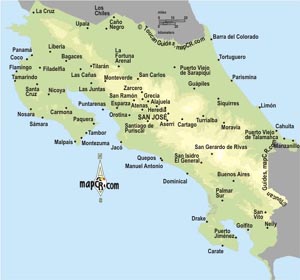 The sight of rolling hills and cattle grazing in the pastures amidst the quietude and serenity was very soothing as we were greeted by a faint drizzle when we arrived at the front gates. As the clouds descend from the mountain tops and envelop the flora and fauna, the beauty of the mists settling down is breathtaking. It rained quite heavily as one would expect it to in a tropical rain forest, and when it ceased, the lush greenery all around and the dazzling colors of some incredibly beautiful flowers coupled with the sweet sounds of birds was truly magical.
The sight of rolling hills and cattle grazing in the pastures amidst the quietude and serenity was very soothing as we were greeted by a faint drizzle when we arrived at the front gates. As the clouds descend from the mountain tops and envelop the flora and fauna, the beauty of the mists settling down is breathtaking. It rained quite heavily as one would expect it to in a tropical rain forest, and when it ceased, the lush greenery all around and the dazzling colors of some incredibly beautiful flowers coupled with the sweet sounds of birds was truly magical.
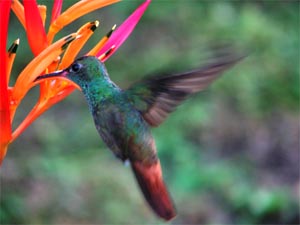
Early at daybreak it was time to take a stroll in the woods to watch birds and dissolve into nature. We spotted several varieties of hummingbirds alone which was a royal treat.
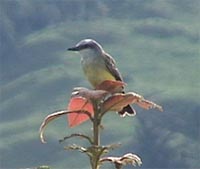 It was fascinating to stop and notice a whole army of leaf cutter ants trudge along the rocks and crevices meticulously carrying their load. As we ventured deeper into the woods, the raindrops falling from the branches and leaves of the treetops mingling with the sound of birds felt like divine music to the ears. The biodiversity of this place is something to marvel at, and everyone that we met here was not only warm and generous but also had a strong awareness of ecological conservation and was practicing it.
It was fascinating to stop and notice a whole army of leaf cutter ants trudge along the rocks and crevices meticulously carrying their load. As we ventured deeper into the woods, the raindrops falling from the branches and leaves of the treetops mingling with the sound of birds felt like divine music to the ears. The biodiversity of this place is something to marvel at, and everyone that we met here was not only warm and generous but also had a strong awareness of ecological conservation and was practicing it.
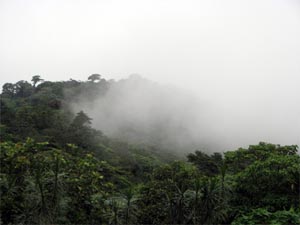 At an altitude of 1200 meters the air was crisp and refreshing and we were able to actually see the Arenal volcanic mountains some 100 kms away, which was to be our next stop. As we drove to La Fortuna in the Arenal valley, a heavy downpour set in and driving through small villages, you could notice red soil being washed away down the mountain slopes in a torrent of rainwater; a clear sign of soil erosion due to heavy deforestation ironically in a country that places a lot of emphasis on ecological conservation.
At an altitude of 1200 meters the air was crisp and refreshing and we were able to actually see the Arenal volcanic mountains some 100 kms away, which was to be our next stop. As we drove to La Fortuna in the Arenal valley, a heavy downpour set in and driving through small villages, you could notice red soil being washed away down the mountain slopes in a torrent of rainwater; a clear sign of soil erosion due to heavy deforestation ironically in a country that places a lot of emphasis on ecological conservation.
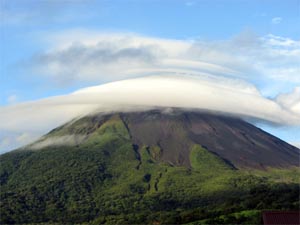 Having arrived at our destination, we could get a much closer look at the Arenal volcano from our room, but we soon learnt that, strange as it may sound the lava flow from the volcano changes direction every six months and we were on the wrong side of the mountain! This meant that we had to drive to the other side of the mountain which was not much of a problem until we reached an unpaved road where we had to drive for about 10 kms to reach the Arenal Observatory. Needless to say, the drive was quite rocky, but we stopped to see some beautiful Northern Jacana birds and several howler monkeys. Approaching the mountain one is reminded of the archetypal symbolism that Mircea Eliade so profoundly discusses in his seminal work, “The Myth of the Eternal Return” and indeed the earliest dwellers in this region may have attached a special significance to the Arenal Mountain.
Having arrived at our destination, we could get a much closer look at the Arenal volcano from our room, but we soon learnt that, strange as it may sound the lava flow from the volcano changes direction every six months and we were on the wrong side of the mountain! This meant that we had to drive to the other side of the mountain which was not much of a problem until we reached an unpaved road where we had to drive for about 10 kms to reach the Arenal Observatory. Needless to say, the drive was quite rocky, but we stopped to see some beautiful Northern Jacana birds and several howler monkeys. Approaching the mountain one is reminded of the archetypal symbolism that Mircea Eliade so profoundly discusses in his seminal work, “The Myth of the Eternal Return” and indeed the earliest dwellers in this region may have attached a special significance to the Arenal Mountain.
Originally set up as a research lodge for scientists from the Smithsonian, the Arenal Observatory offers one of the most stunning views of the Arenal Volcano in the midst of the tropical jungle. We could hear the rumblings of the volcano and after every eruption, white hot rocks were ejected that were hurled down the mountain. It was quite a cloudy day and the visibility was not that good at the summit of the mountain.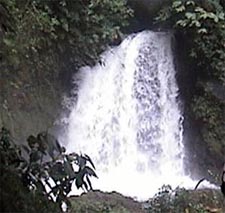 We soon set out on a trekking expedition at the end of which we came upon some majestic waterfalls. We returned back to the observatory and in spite of a cloudy night, witnessed a spectacular display of red hot lava and rocks spewing out of the volcano, which made the trip worthwhile. After returning back on the rocky path once again, it was now time for a dip at the Tabacon Hot Springs, a naturally heated springs which has its origins at the base of the volcano, to soothe the body and mind.
We soon set out on a trekking expedition at the end of which we came upon some majestic waterfalls. We returned back to the observatory and in spite of a cloudy night, witnessed a spectacular display of red hot lava and rocks spewing out of the volcano, which made the trip worthwhile. After returning back on the rocky path once again, it was now time for a dip at the Tabacon Hot Springs, a naturally heated springs which has its origins at the base of the volcano, to soothe the body and mind.
It was time to leave Arenal, but first we stopped at a sugarcane field, and manually operated a sugarmill to squeeze fresh sugarcane juice which tasted simply delicious. Then we headed east towards Puerto de Viejo Sarapiqui in the Caribbean lowlands and after passing through several small towns and villages we finally reached the town of Horquetas.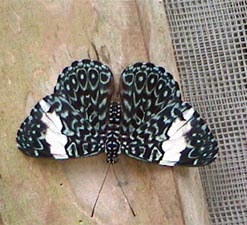 There is never a dull moment in Costa Rica for when we neared Horquetas we had to cross a Bridge over the river Sarapiqui that was quite an adventure in itself. The Sueno Azul resort is set in the sleepy town of Horquetas amidst the tropical rain forests and again you are close to nature, sometimes a little too close as you can have some unexpected visitors in your room. Once again early in the morning it was time for more birdwatching and we spotted several Northern Jacanas, Cattle Egrets and thrushes. And then it was time to visit the rodeo and go horseback riding into the tropical jungle. As the horses trotted up the slopes crossing small brooks and streams, we noticed several Caimans that were probably about two feet long resting on a log. We then stopped by at a butterfly farm to look at some humongous but beautiful butterflies that had brilliant iridescent colors and awesome designs. Eventually we came to a natural waterfall and took a dip in a cool pond that was exhilarating.
There is never a dull moment in Costa Rica for when we neared Horquetas we had to cross a Bridge over the river Sarapiqui that was quite an adventure in itself. The Sueno Azul resort is set in the sleepy town of Horquetas amidst the tropical rain forests and again you are close to nature, sometimes a little too close as you can have some unexpected visitors in your room. Once again early in the morning it was time for more birdwatching and we spotted several Northern Jacanas, Cattle Egrets and thrushes. And then it was time to visit the rodeo and go horseback riding into the tropical jungle. As the horses trotted up the slopes crossing small brooks and streams, we noticed several Caimans that were probably about two feet long resting on a log. We then stopped by at a butterfly farm to look at some humongous but beautiful butterflies that had brilliant iridescent colors and awesome designs. Eventually we came to a natural waterfall and took a dip in a cool pond that was exhilarating.
We then left for the final leg of our trip to Manuel Antonio on the Pacific Coast to enjoy the ocean and visit the Manuel Antonio National Park. The drive through the countryside was spectacular and it was blissfully scenic as we passed through the Brauilo Carrillo National Park.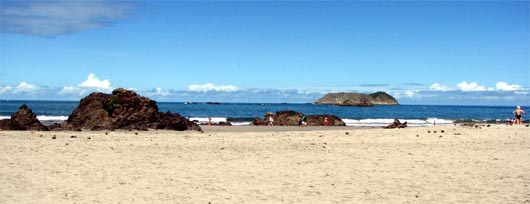
While we were taking in the sights and sounds, there was quite a rustle in the trees below and soon out of nowhere a whole bunch of Titi or squirrel monkeys clamored in to feast on fruits. Just before entering the park we had a hard time finding a good tour guide, which is an absolute necessity if you need to spot wildlife while trekking inside the dense forests.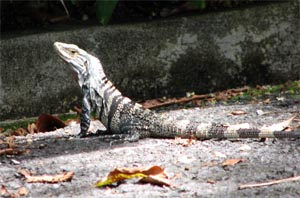 Finally we ended up getting a wonderful guide who could spot a sloth a mile away and he helped unravel the mysteries of the tropical rain forests. We spotted an agouti, which is a giant rodent with no tail, several sloth bears up in the trees sitting or slouching fifty feet above the ground, some of which were two toed and others three toed, black lizards, which are about the size of an iguana, some remarkably colorful spiders, cicadas, bats, a rather large orange colored crab, a grey hawk and graceful pelicans.
Finally we ended up getting a wonderful guide who could spot a sloth a mile away and he helped unravel the mysteries of the tropical rain forests. We spotted an agouti, which is a giant rodent with no tail, several sloth bears up in the trees sitting or slouching fifty feet above the ground, some of which were two toed and others three toed, black lizards, which are about the size of an iguana, some remarkably colorful spiders, cicadas, bats, a rather large orange colored crab, a grey hawk and graceful pelicans.
On the drive back, as we passed the bridge at Tarcoles, we stopped to see the saltwater crocodiles that were lazing on the riverbanks with their jaws wide open. Finally it was time to return to San Jose, but it was very difficult to bid adios to this remarkably beautiful land full of lush vegetation and the warm and hospitable people that make up Costa Rica.
05-Aug-2007
More by : Subra Narayan